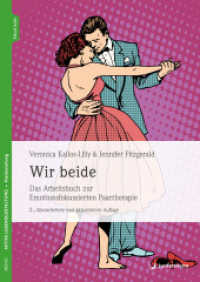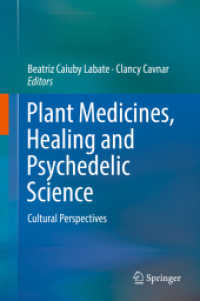- ホーム
- > 洋書
- > 英文書
- > Literary Criticism
Full Description
Written texts of the Iliad and the Odyssey achieved an unprecedented degree of standardization after 150 BCE, but what about Homeric texts prior to the emergence of standardized written texts? Orality, Textuality, and the Homeric Epics sheds light on that earlier history by drawing on scholarship from outside the discipline of classical studies to query from three different angles what it means to speak of Homeric poetry together with the word "text".
Part I utilizes work in linguistic anthropology on oral texts and oral intertextuality to illuminate both the verbal and oratorical landscapes our Homeric poets fashion in their epics and what the poets were striving to do when they performed. Looking to folkloristics, part II examines modern instances of the textualization of an oral traditional work in order to reconstruct the creation of written versions of the Homeric poems through a process that began with a poet dictating to a scribe. Combining research into scribal activity in other cultures, especially in the fields of religious studies and medieval studies, with research into performance in the field of linguistic anthropology, part III investigates some of the earliest extant texts of the Homeric epics, the so-called wild papyri. By looking at oral texts, dictated texts, and wild texts, this volume traces the intricate history of Homeric texts from the Archaic to the Hellenistic period, long before the emergence of standardized written texts, in a comparative and interdisciplinary study that will benefit researchers in a number of disciplines across the humanities.
Contents
0: Introduction
Part I: Oral Texts and Oral Intertextuality
1: Oral Texts and Entextualization in the Homeric Epics
Introduction
1.1: Performance, Oral Texts, and Entextualization
1.2: Application to the Homeric Epics
1.2.1: The Preexistence of Tales and Songs and the Object-Like Status of Utterances in the Homeric Epics
1.2.2: Entextualization in the Character Text I
1.2.3: Entextualization in the Character Text II
1.2.4: The Poet and Entextualization
1.3: Homerists on Texts
2: Oral Intertextuality and Mediational Routines in the Homeric Epics
Introduction
2.1: Oral Intertextuality and Mediational Routines
2.2: Mediational Routines in the Homeric Epics
2.2.1: The Source Text
2.2.2: The Target Text
2.3: Metapoetic Implications
Part II: The Emergence of Written Texts
3: Textualization: Dictation and Written Versions of the Iliad and the Odyssey
Introduction
3.1: The Dictation Model
3.2: A Comparative Approach
3.3: The Process of Recording by Hand
3.3.1: The Challenges of Manual Transcription
3.3.2: Steps to Work around These Challenges and Their Effects
3.3.3: The Rare Exceptions
3.3.4: Dictated Texts versus Sung Texts
3.3.5: What Was Written Down
3.3.5.1: The Collector as Gatekeeper
3.3.5.2: The Scribal Process
3.4: The Collector's Impact on the Oral Text
3.4.1: Unwitting Interference (or the Collector's Presence)
3.4.2: Purposeful Interference
3.5: Editing
3.5.1: Field Notes
3.5.2: Editorial Work in the Nineteenth and Twentieth Centuries
3.5.3: Editorial Work from the Second Half of the Twentieth Century until Today
3.6: Best Practices
3.7: The Collector's Text versus the Performer's Oral Performance
3.8: The Formulations in Section 3.1 Reevaluated
3.9: The Evolutionary Model's Transcript
Excursus: The Interventionist Textmaker and Herodotus's Histories
Part III: Copying Written Texts
4: The Scribe as Performer and the Ptolemaic Wild Papyri of the Homeric Epics
Introduction
4.1: The Ptolemaic Wild Papyri of the Homeric Epics
4.2: The Nature of the Variation: Not Scribal Error
4.3: Accounting for This Variation
4.4: The Scribe as Performer
4.5: The Scribe as Performer and the Wild Homeric Papyri
4.5.1: The Wild Papyri and the Comparanda
4.5.2: When?
4.5.3: Who?
5: Scribal Performance in the Ptolemaic Wild Papyri of the Homeric Epics
Introduction
5.1: Juxtaposing the Wild Papyri and Helmut van Thiel's Text
5.2: Competence and Entextualization
5.2.1: Cohesion
5.2.2: Coherence
5.3: Competence and Completeness
5.3.1: Characters Do More Things
5.3.2: Nothing Is Assumed
5.4: Competence and "Affecting Power"
5.4.1: The Emotions
5.4.2: The Fulfillment of Expectations and the Groove
5.5: Tradition, Traditionalization, and the Intertextual Gap
5.6: The Bookroll
5.7: The Performing Scribe
5.8: Scribal Performance and the Alternatives
6: Conclusion
Endmatter
Works Cited
Index








